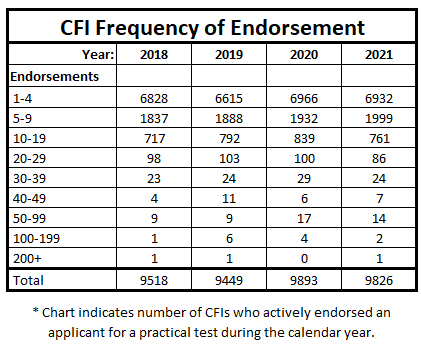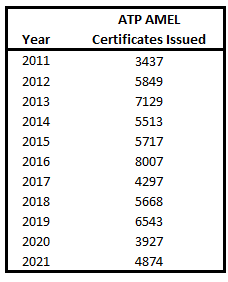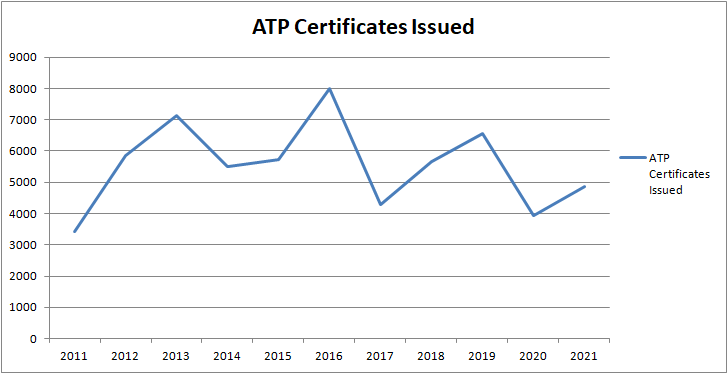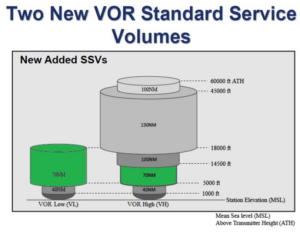Ever wonder how you compare to other CFIs when it comes to how many applicants you sign off for a practical test in a given year? The good news is that in a general sense we can help you figure that out.
The FAA shares some data with industry members on how many CFIs sign off an (or multiple) applicants for practical tests each year. in ranges.
With that said, here is the table of those signoff statistics for the least few years, with the freshly shared 2021 statistics included:

As you can see from the bottom numbers, less than 10,000 CFIs endorse EVEN ONE applicant for a practical test on any given year. There are currently well over 110,000 CFI active CFI certificates, although as of January 1, 2022, only 83,596 of those had an active medical certificate, which means a small percentage of the total CFI certificate holder population is actively endorsing applicants for certificates and/or ratings on any given year. While I have covered this in previous posts, this doesn’t mean none of these CFIs are doing any instruction. They could be doing flight review, IPC, currency instruction, or none of this. Many of them are actively flying as professional pilots. However, it does not go without notice to me that in 2020 nearly 20% of the CFI population was over the age of 65. I will update these numbers in a future post when the full set of 2021 data and certification numbers is available.
This data again highlights the fact that is a small subset of the CFI population that is doing the bulk of the training for certificates and/or ratings. It also highlights the fact that the largest numbers of CFIs only endorse a small number of applicants each year. This trend has not changed over the recent years. In any given year, fully two-thirds of those CFIs that do endorse an applicant do less than 5 of them.
So, with that, if you are a CFI, you can now take a look at where you might fall in these ranges.
If you happen to be one of the few CFIs endorsing higher numbers of applicants for practical tests, you are certainly in limited company!
The aviation industry is without a doubt in need of pilots to serve in the front offices, airline flight decks, that transport people and goods throughout the United States and internationally. There was a certain downturn in 2020 and a big part of 2021, but it appears that the downturn is recovering. While aviation training in many lower-level certificate issuance efforts didn’t change to a great deal, we did see 2020 indicate a large reduction in the number of ATP certificates issued. This was directly related to the fact that airlines stopped running hiring classes at which ATP CTP classes were completed and where pilots completed ATP certification.
As 2021 continued and hiring again ramped up, many of these airlines started running classes and certifying the next batches of ATP pilots. We can see this from the preliminary data that has been shared with some in the industry.
From the following table and chart, we can see that ATP certificates increased in 2021 from the low point in 2020 when COVID-19 shutdowns were most greatly affecting certification efforts (and service needs).

When we look at the 10-year table of certificates issued we still see the trends of heavy issuance years when the “1500 hour rule” took effect during 2015 and 2016, and then a more normalized flow of ATP production in 2017, 2018, and 2019 as active hiring took place and airlines trained their next generation.
The dropoff in 2020 was obvious and big, but it does appear that the trend of certification numbers is increasing as 2021 continues and airlines provide most of the training for and certification of the next generation ATP applicants.
This trend will need to continue to serve the needs of the aviation transportation industry. The good news is that it appears the numbers are heading in a positive direction as we look at preliminary reporting of ATP certification numbers from 2021.

Many of us have memorized the minimum VOR service volumes for various VOR types, Terminal, Low, or High as a part of our training or the training and testing we provide. But those days are changing.
As the FAA navigation system changes to a Minimum Operational Network (MON) with respect to VORs, service volumes and availability of VORs is going to change. With those changes, so will the scenarios that we need to teach, and that DPEs will test on practical tests. Not just for testing purposes, but for practical air navigation purposes so pilots, especially IFR ones, know what resources they have available and how to use them.
The plan for the FAA MON with respect to VORs is intended to be a “reversionary service provided by the FAA for use by aircraft that are unable to continue RNAV during a GPS disruption.” There are lots of technical details here, but the gist is that how we use VORs is going to be changing as we move forward in our navigation system.
Some hot topics that might be great fodder for training and testing include the following considerations:
What VORs are still working?
How can a pilot, a student, or a testing applicant determine what VORs are still in service and able to be used for navigation, or alternate if GPS becomes unavailable is a really important skill to develop. Making sure to understand this and how to resource this is a critical pilot and student skill.
NOTAMs are a pretty critical tool in this process. As many VORs are transitioned out of the system, reviewing NOTAMs about specific navigation sources will be a part of determining if a particular site is useable. Just because it is on the chart doesn’t mean it is useable anymore.
How Far Can I Use a VOR?

Transitioning from the older three type of VOR range system, the FAA is working to make some of the VORs work for longer ranges. With a focus on navigation above 5000’ for the longest ranges, a more traditional 40 NM range will be present at most VORs lower than 5000’ that would be used for approaches if needed. The primary navigation range for most general aviation aircraft will change from a 40NM range to a 70NM useable range with means distanced between two MON VORs will increase from a more historic 80NM between VORs to a 140NM VORs for enroute usage below 18,000’ MSL. Continue reading
